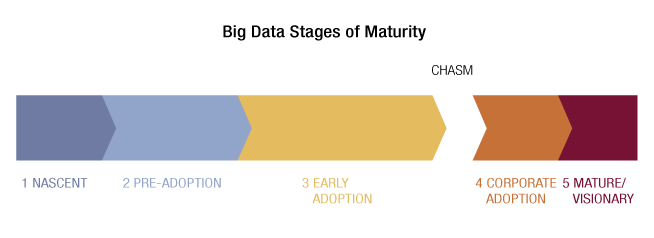3 Interesting Results from the Big Data Maturity Assessment
Almost a year has passed since the launch of the TDWI Big Data Maturity Model and assessment tool, which I co-authored with Krish Krishnan. To date, more than 600 respondents have participated in the assessment.
We asked questions in five categories relevant to big data:
- Organization: To what extent does your organizational strategy, culture, leadership, and funding support a successful big data program? What value does your company place in analytics?
- Infrastructure: How advanced and coherent is your architecture in support of a big data initiative? To what extent does your infrastructure support all parts of the company and potential users? How effective is your big data development approach? What technologies are in place to support a big data initiative, and how are they integrated into your existing environment?
- Data Management: How extensive is the variety, volume, and velocity of data used for big data analytics, and how does your company manage its big data in support of analytics? (This includes data quality and processing as well as data integration and storage issues.)
- Analytics: How advanced is your company in its use of big data analytics? (This includes the kinds of analytics utilized, how the analytics are delivered in the organization, and the skills to make analytics happen.)
- Governance: How coherent is your company’s data governance strategy in support of its big data analytics program?

Respondents answered 75 questions across these categories and were given a score for each category. Scores correlated with stages of maturity, including nascent, pre-adoption, early adoption, corporate adoption, and mature/visionary. (Get more information about the Big Data Maturity Model by downloading the guide.)
So what are we seeing? Where are organizations in terms of big data maturity?
In a word: early—at least for organizations that took this assessment. The majority self-reported that they had nothing in place for big data or were just in the experimentation phase.
Only a small percentage of respondents are organized to execute on big data initiatives.
When we averaged scores across all five dimensions, the mean scores put respondents between the pre-adoption and early adoption stages—when organizations are thinking about big data and may have some proof of concepts going.
However, here are three results worth noting:
- Respondents are not organized to execute. Only a small percentage of respondents are organized to execute on big data initiatives. About 25% of respondents had a road map or a strategy in place for big data. In addition, about one-quarter had some sort of funding process in place for dealing with big data projects. Although organizations scored higher on "soft" questions such as whether they thought they had an analytics culture in place, scores still put many in the pre-adoption phase.
- The data warehouse is cited most often as the infrastructure for big data. We asked respondents what kind of infrastructure they had in place for big data. A sign of maturity for big data is to take a hybrid ecosystem approach. In other words, organizations often have a data warehouse (or marts) in place, but supplement it with other tools for other jobs. Hadoop or an analytics platform might work in conjunction with the warehouse, for instance. Some organizations might use some infrastructure in the cloud. About one-third of respondents stated that their data warehouse was their core technology for big data. Another one-third stated they didn’t have a big data infrastructure. The rest had some combination of technologies in place, but they were often siloed.
- More advanced analytics are happening on big data, but in pockets. On the analytics front, organizations were often collecting data they weren’t analyzing. About half of the respondents stated that they were performing advanced analytics (i.e., predictive analytics or other advanced techniques), but it was happening in pockets. It was also a bit unclear whether they were analyzing big data as part of their advanced analytics efforts. Many respondents were still trying to put their big data teams together. Few had a center of excellence (COE), where ideas are shared, governance exists, and training takes place.
I’ll continue to share interesting and notable results from the Big Data Maturity Model Assessment. In the meantime, if you haven’t taken the assessment, I encourage you check it out here.

What’s next? TDWI set to launch new analytics maturity model in late 2014
TDWI is excited to announce our plans to launch a new assessment, which we're calling the Analytics Maturity Model. Like the Big Data Maturity Model, this model has an assessment associated with it. Unlike the Big Data Maturity Model, this model focuses on analytics maturity across the spectrum of BI and analytics techniques and infrastructures. I’ll be writing more about this maturity model in the coming weeks. Stay tuned!
Posted by Fern Halper, Ph.D. on October 16, 2014